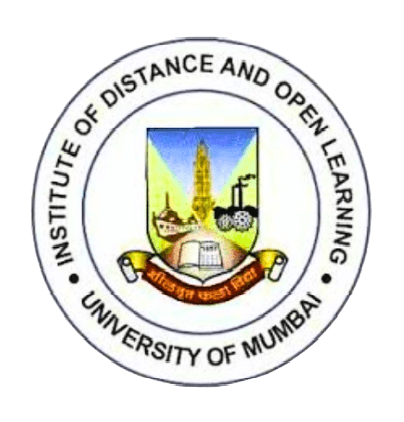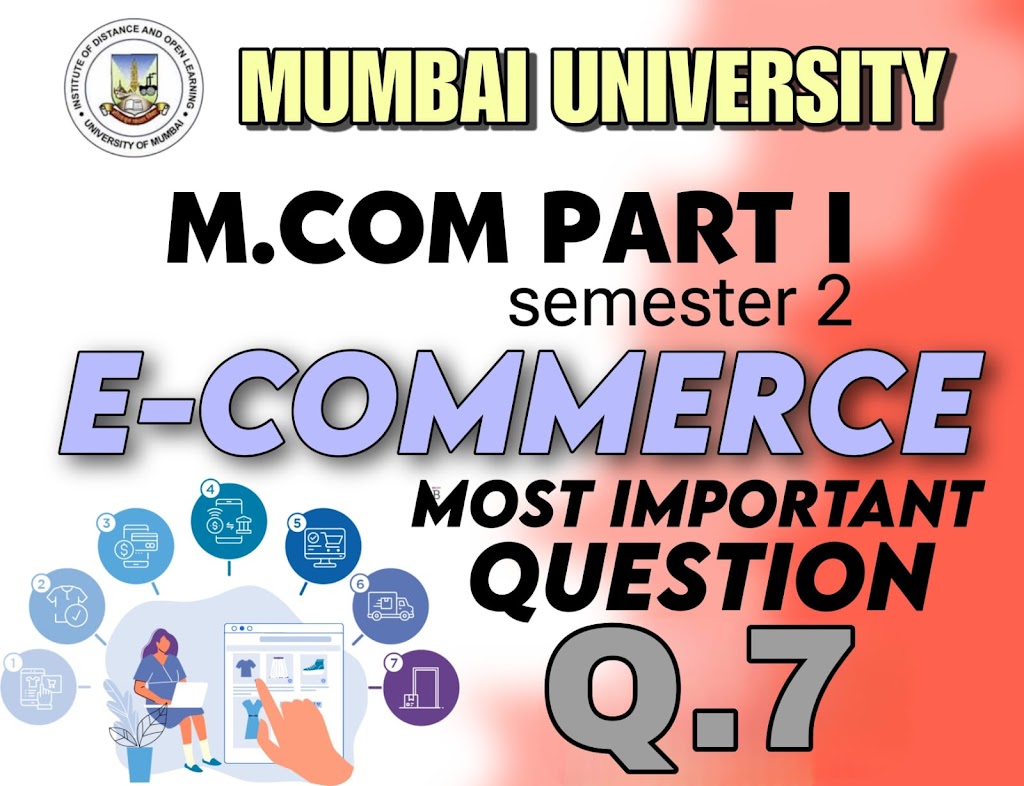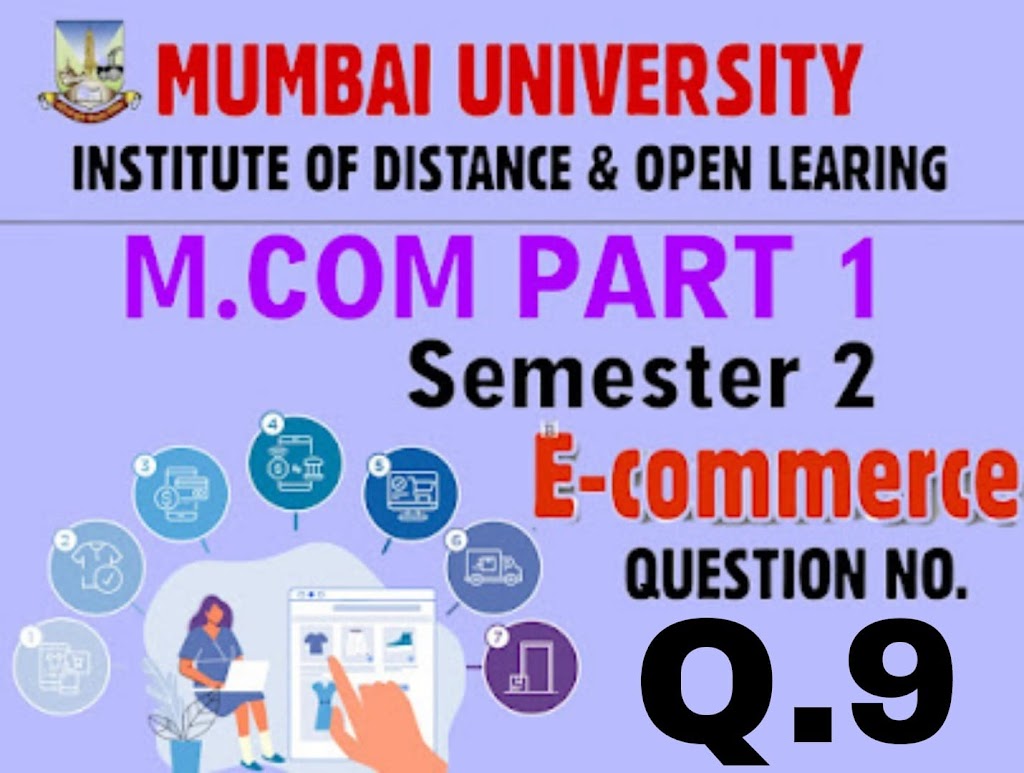e- commerce m.com question papers with answers pdf mumbai university
M.com Part 1 (Semester 2) E- COMMERCE Most Important Question Bank for Current Exam Q.7 Discuss the characteristics of B2B model of e-commerce ANS: 1) Custom pricing features: With a B2C e-commerce website, pricing is usually simple as every customer gets the same price. B2B ecommerce websites, there might be different pricing for different customers. It could be because of the volume of business they do with them, the frequency of orders, or the type of products they buy. 2) Custom Bulk Discount: Bulk discounts are a common feature of B2B businesses. They are a way of encouraging higher order values and building customer loyalty. They can be based on the quantity or purchase amount. 3) Minimum order quantities: In addition to policies like discounts for buying in bulk, many B2B stores also operate a minimum order value for all or some of their products. Minimum order quantities are often essential for managing margins and ensuring that B2B e-commerce company remain profitable. 4) Flexible Payments: Having flexible payment options is an advisable feature for any ecommerce store, but it is particularly important for B2B businesses. B2B E-commerce company can offer flexible p ayment option along with selected days credit facility. 5) Omni-Channel Presence: Scalable, responsive, and fully customized e-Commerce platform solutions including mobile app and website for B2B e-Commerce gives comfort and ease to customer at online store. 6) More business opportunities: A web store can help strengthen online presence, letting potential clients and resellers find B2B e-commerce Company through search engines. This is especially effective the company chooses to make its catalog pages public. However, even if it decides to keep catalog private, company can use targeted marketing content (Customers to whom a company wants to direct its marketing efforts and o sell its products and services) in web store to grab the attention of new clients. 7) Fewer customers: In the B2B e-commerce, there are fewer number of customers. Although the market is small with fewer buyers and sellers, but their orders are big. 8) Stability and Loyalty: In B2B e-commerce, there is a very stable relationship between buyer and seller that goes for years. Before signing any contract, buyers and sellers both plan their budget, revenues, and rates. When both parties close the deal, then they rely on one another in terms of supplies and payments. So parties are loyal to one another. 9) Lower cost: In B2B e-commerce, both parties spend a lot of time planning and working on the details. In most cases, the work is done through automation (including order entry, client information provision and customer service) that eradicates the chances of errors and undue expenditure. Therefore, it leaves no room for mistakes and errors. As a result, everything works out as plan without costing any extra expenses. This especially true with ERP-integrated B2B ecommerce. 10) Design easy order system: B2B companies selling online need to put much effort into designing a website and ordering system that buyers find easy to use. This means presenting product and service information clearly, offering online demos or consultations and using order forms with appropriate options for quantities and any special customization needed. 11) Reduces Distribution Costs: B2B transactions reduce marketing and sales costs of the sellers. Eg. A seller need not to advertise heavily to attract customers. Also, the seller need not maintain a large number of sales force and support staff. 12) Reduces Inventory Levels: A seller need not maintain large inventory levels in anticipation of demand. The seller can maintain the level of inventory based on the orders received online. Therefore, the cost of maintaining inventory is less. Also, the buyer need not keep a large amount of inventory. He can order for inventory as and when required. The seller can supply the inventory under the just-in-time model. Therefore, the cost of maintaining inventory is also less for the buyer. 13) Benefit of Negotiation: B2B permits negotiation between buyer and seller relating to price quantity and other terms and conditions of sale. However, negotiation is not possible in case of B2C model. Negotiation benefits both the parties and therefore, there is higher conversion of sales as compared to B2C model. 14) Lower Rejection Rate: Under B2B model, there is lower rejection rate as compared to B2C model. B2B model permits negotiation between the buyer and the seller. Also the sales representatives of the seller meet the buyer with samples and also provide clarifications, whenever required. Therefore, the return of goods is lower in the case of B2B model, which in turn reduces the cost for the seller. M com sem 1 e commerce imp questions in exam paper 2024 M com sem 1 e commerce imp questions in exam paper 2023 m.com part 1 question papers with answers idol m.com sem 1 question papers mumbai university e-book m.com question papers with answers pdf mumbai university e-commerce important questions and answers pdf e-commerce important questions unit wise e-commerce important questions pdf m.com question papers with answers pdf mumbai university e-commerce question paper mumbai university mumbai university solved question papers download pdf mumbai university previous year question papers with solutions m.com part 2 sem 2 question paper mumbai university If you want exam most important question bank pdf then you have to pay per subject 100/- rupees only . Contact 8652719712 / 8779537141 Telegram Group Mumbai Univeersity :- https://t.me/mumbaiuniversityidol Suraj Patel Education :- https://t.me/surajpateleducation F.Y.J.C EXAM :- https://t.me/FYJCexam S.Y.J.C EXAM :- https://t.me/SYJCexam F.Y EXAM :- https://t.me/fyexam S.Y EXAM :- https://t.me/syexam T.Y EXAM :- https://t.me/tyexam M.Com Part 1 EXAM :- https://t.me/McomPart1Exam M.Com Part 2 EXAM :- https://t.me/McomPart2Exam M.A EXAM :- https://t.me/mastudentsexam YouTube Channel https://www.youtube.com/channel/UCv8JIY58xfWHUIXVu9wxNHw











